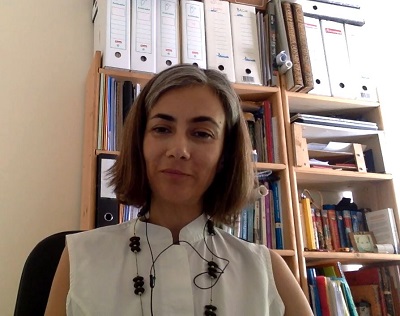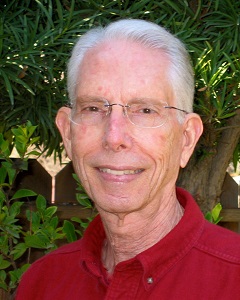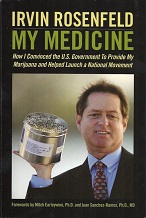Excerpted from Brave New Weed: Adventures into the Uncharted World of Cannabis[1] by Joe Dolce
One of the problems of the current world of weed is the lack of diverse opinions within it but as we enter the post-prohibition era, new voices are emerging, and they are countering the received wisdom.
Michael Backes is one such disrupter. Rather than joining the chorus of those who claim that cannabis is harmless in any amount and in all circumstances, he takes the more epicurean position that it is currently oversmoked and underutilized. As a founding member of Phytecs, the first company devoted to making plant-based medicines and nutraceuticals to treat the endocannabinoid system, Backes is itching to spark a new debate about how the plant can responsibly fit into a society that doesn’t outlaw or demonize it. He’s convinced of cannabis’s untapped potential, but he’s unconvinced that stoners will be leading the way to uncovering it.
When I was growing up in the 1970s, a joint rolled was a joint smoked down to the roach. We continued smoking stupid no matter how potent pot became. But to get interesting highs that don’t knock you flat, twenty-first-century cannabis should be consumed in a twenty-first-century way. Backes says dose control is key.
Dose is one of the few ways that cannabis mirrors alcohol. One or two drinks can act as a social lubricant; five can make you socially disconnected. Aspirin is another example. At 600 milligrams, aspirin reduces pain and inflammation. At 100 to 160 milligrams, it unclogs arteries.3 The relationship between dose and effect wasn’t firmly established until Dr. Mark Wallace at the University of California, San Diego, injected capsaicin, the ingredient in chili pepper that burns, into the arms of volunteers and then treated them with varying doses of cannabis. At too low of a dose, subjects got no pain relief. A moderate dose provided excellent relief, but too high of a dose actually magnified the pain. The conclusion? Cannabis is so dose specific that large and small amounts create opposite effects.
“Because it’s nontoxic there’s been no guidance and that’s a problem,” says Backes. “With tequila, someone might say, ‘Don’t drink five shots or you’ll be unhappy.’ No one says that with pot. They think that once you reach a certain level of psychoactivity you’ll automatically know when to stop. You won’t.
“A lot of people say they stopped smoking at some point because it made them paranoid. What’s making them paranoid is an overdose of THC. Reduce that and it goes away. It took me a year to figure out to smoke a match head instead of a bowl.” Binge smoking or oversmoking is yet another unforeseen result of prohibition, he contends, just as binge drinking became the norm in the 1920s and ’30s, when drinkers would stockpile and guzzle as much grain alcohol as they could because they never knew where their next batch was coming from.
The second key to taming today’s pot is understanding the role that the lost molecule, CBD, plays in modulating the high. Without it, aficionados claim the plant has morphed from something that produces a complex and subtle enhancement—think wine—to a powerful fuel, like grappa. CBD is often misidentified as the “high- less” weed, but in my experience it creates a subtle, warm feeling— more of a flat “mid” than a rip-roaring high. This uninspiring semi-high is why growers in the 1980s and ’90s bred CBD out of the plant. If the strains didn’t send them flying, they would chuck the seeds to ensure they didn’t produce another bum crop. It’s why today’s potent pot is often misconstrued as “great.”
The problem with THC-only pot is that it’s not what nature, in her infinite wisdom, intended. THC is a tricky chemical. It can be trippy, imparting sunny feelings of joy, but too much can create a trifecta of unpleasantness: paranoia, anxiety, and nausea. Here’s why: When administered together, THC and CBD play Rock ’Em Sock ’Em Robots in the battle to fill receptors. But THC is much more adhesive than CBD; it’s Superglue compared with CBD’s old tape. THC usually lands first, but CBD will run interference, which tempers THC’s effects. Even though they are often described as antagonists, they are more like old lovers. Yes, they fight, but overall they get on best when they’re together.
One of CBD’s less regaled attributes is its ability to dampen anxiety. One Brazilian research team demonstrated its usefulness in overcoming stage fright. It’s a well-known dictum that people fear public speaking more than death; but when the subjects of this 2011 study were given CBD before taking the stage, it decreased their discomfort, anxiety, and sweating, and calmed their heart rates.5
To support this contention, Backes reminds me of this often- forgotten bit of cannabis ephemera: The Beatles, Charlie Parker, Carl Sagan, Bob Dylan, Allen Ginsberg—all the artists, writers, and thinkers that extolled cannabis for its creative fuel—weren’t imbibing 25 percent THC. Their smoke was 4 or 5 percent THC, and it very likely contained an equal measure of CBD.
“When Dylan turned on Paul McCartney, Paul asked his assistant to follow him around and record the flood of ideas that cannabis was triggering. If he had smoked that amount of today’s pot he’d have been on his back. Those creative highs had nothing to do with the stony Cheech and Chong highs. In California right now you can’t find anything under eight percent THC, and that’s twice as strong as what they were smoking.” Perhaps the real act of creativity lies in knowing how much to use to get you where you want to go.*
According to Backes, educated Californians are now using cannabis more as a precision instrument than a sledgehammer. The key words here are “education” and “precision.” You need to know how much to take and how to deliver it into the body. The professionals (mostly in the film industry) Backes knows use a smidgen to open the spigot of creativity and help them get out of their own way. Larger doses are reserved for revising or going deeper into material. Other execs in high-pressure industries are substituting a low-dose 2.5-milligram edible for an afternoon cocktail to soften the rougher edges of the day and maintain calm. Those are far more noteworthy ways of using cannabis than just smoking until you can’t stand up.
**
To understand how to think about designing highs that can change your mind or mood, you need to understand terpenes. These powerful smell molecules, the most common of which are key components in lemon, pepper, lavender, and pine, create the pungent aromas of fresh bud. We’re not talking mild aromatherapy here. Terpenes in cannabis occur in pharmaceutical-grade concentrations. When dried and heated, they combine to form a chemical cascade that may direct the trajectory of the high.
“THC increases how fast terpenes cross the blood-brain barrier,” contends Backes. “Kona Gold, Panama Red, Acapulco Gold, all these great seventies genetics that got you beautifully high had lower THC content than strains today, but they had a lot of terpenes.” In other words, THC determines how wide the door to the brain opens; terpenes are the different paths that are illuminated once you walk through.
Backes unfolds a chromatograph that compares the terpene content of two strains, Bubba Kush and Lemon Haze. Both have comparable levels of THC, between 13 and 15 percent, but their highs are different thanks to their terpene mixes. The peaks and dips of the lines resemble the “Random Hill” profile on a stationary exercise bike, but they zig and zag in opposite directions. Bubba Kush has a higher concentration of myrcene and linalool, two terps that cause relaxation. Lemon Haze is richer in pinene and limonene, making it more uplifting and clear.
Although I’ve used the words “indica” and “sativa” throughout this book, they are not reliable indicators of the stimulating or sedative qualities of one strain. In fact, the best indicator of whether a strain will bring you up or down is its terpene profile. “Once you start to know the different terpenes and how they work, you can more reliably predict the effects,” says Backes.
At this point, reading the terpenes is more of a forecast than a road map to each high because of the complicated way they interact with each other, an interplay of chemicals known as the entourage effect. The entourage effect is best understood in musical terms: Individual instruments produce lovely sounds on their own, but the majesty of a symphony can be realized only when all the instruments play together. Terpenes are the violins and flutes, and only when they mix with other cannabinoids can the symphonic complexity of the high be realized. This also explains how cannabis has outfoxed pharmaceutical companies in their attempts to isolate and patent single-molecule medicines. The sum of cannabis’s chemical parts is greater than any one of its individual components. Just as with certain celebrities who walk the red carpet, the major cannabinoids need their entourages to function optimally.
Those of us who live in illegal states smoke what our dealers bring us and hope for the best. But Backes and other pioneers of the new cannabis era are hoping to combine terpenes to engineer effects that are more predictable. The UK-based company, GW Pharmaceuticals, is breeding plants that are high in one minor cannabinoid called THCV, for example, that retards appetite and may work like a diet pill. A natural, plant-based product that gets you skinny and makes you feel happy? Now there’s a business!
But it’s a ways away. In the meantime, I ask Backes what he might recommend for crisp, transparent highs that will also relieve the stiffness of my lumbar and cervical vertebrae, my occasional insomnia, and the other indignities of aging.
For physical issues, he recommends low-dose aspirin, eighty milligrams every day for inflammation, and a high-CBD cannabis strain to ease the pain.
To sleep, I’m to take a vapor hit or two one and a half hours before bed—that will allow the high to fade in time to allow the metabolites that encourage sleepiness to kick in. And he recommends a low-dose (2.5 – 5 mg) edible just before I hit the pillow. The effects will come on after an hour, which should carry me through the night.
“To counteract morning fuzzies, eat two tablespoons of almond butter before bed. That keeps your sugar level even so you wake up sharp. For some, slow-morning starts are age related, for others it’s insulin resistance. In either case it works like a charm.
“For your high, a pinene-enhanced narrow-leaf variety appears to intensify psychoactivity and eliminate memory deficits. It’s not much guesswork, because you are very specific: whereas most people are just getting stoned, you want to get high. A sublingual candy once a day will also extend the length of a high,” Backes tells me. “I always make sure to have THC in a ratio with CBD that works for me. And remember, microdosing promotes hyperfocus and avoids bounce-back.”
Bounce-back?
“The endocannabinoid system (the receptor system in the human body which the chemicals in cannabis trigger) loves balance. If you hit yourself with a big dose, your body’s going to try to balance out, so the system will swing back in the other direction. It’s like riding a seesaw. Two people of the same weight can balance but if some big guy jumps on one end, the little guy on the other end is going to lose his teeth. When you dabbed, you got hit in the teeth.
“What you probably want is something that goes up and comes down smoothly without a peak. Personally, I don’t want an intense high. I want a gentle onset, a long-lasting effect, and then some- thing that just disappears.”
References
- ^ Brave New Weed: Adventures into the Uncharted World of Cannabis (www.amazon.com)
Read more http://hightimes.com/culture/the-next-frontier-designing-your-high/
Latest
Coronavirus Strikes Massachusetts Cannabis Company Employees
Reassessing the Essential: Cannabis in the Time of a Pandemic
5 Reasons To Try Aspen Valley CBG Flower (30% Off)
High Times Cannabis Cups Go Virtual In Wake Of Coronavirus Pandemic
Drug Enforcement Administration Proposes Plan To Expand Cannabis Research
Ghana Legalizes Cannabis For Medicinal And Industrial Uses
The cheapest legal weed in Canada: Discover these cannabis ‘value brands’
Cannabis and coronavirus: Here’s what you need to know
cannabis designs
The Best Of
WHO Rules CBD Should Not Be a Scheduled Drug

Dr Cristina Sanchez PhD video interview on medical marijuana and cancer

Biochemist Dennis Hill interview; Cannabis oil as a cure for cancer.

The unofficial World Record holder for cannabis smoking part 1




